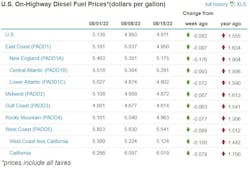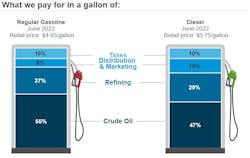Diesel is on a sustained decline, as the U.S. average price for trucking’s main fuel dropped for the eighth straight week, down 8.2 cents to $4.911 per gallon. The fuel is now down below $5 in every region of the country, except the West Coast, according to new federal data for the week of Aug. 15.
The last week with an increase was June 20, when diesel reached a U.S. record of $5.81 per gallon, according to data from the U.S. Energy Information Administration (EIA). Those days are increasingly distant as the distillate reaches the second month of price declines, though the fuel is still $1.555 per gallon more expensive than it was a year ago.
See also: Diesel down nationally below $5 per gallon
According to motor club AAA, the U.S. average for diesel hasn’t yet dropped below the $5-per-gallon threshold and now sits at $5.033 per gallon, a 1.2-cent decline from the previous day and 11 cents below the average from the previous week. AAA tracks the diesel and gasoline averages daily and weekly, whereas EIA releases its fuel numbers weekly. AAA also breaks them down state-by-state, while EIA does so by region and subregion.
Gas prices fall below $4 per gallon
Gasoline also fell below $4 a gallon nationally and well below that mark in many regions of the country. The U.S. average for gas was $3.938 for the week of Aug. 15, down a dime from the previous week. However, gas is now 76.4 cents more per gallon than it was a year ago, according to EIA.
See also: ATRI: Trucking endures 'costliest year ever'
AAA had the national average for gas sliding below $4 per gallon to $3.956, a 10.3-cent drop from the week before and a decline of less than a penny from the day before. Gasoline, according to AAA, was its highest on June 14 at $5.016 per gallon.
Also, not only is demand for distillates down, but crude inventories are up, according to Oil & Gas Journal, FleetOwner's sister publication. U.S. crude inventories were up 5 million barrels on Aug. 5, according to O&GJ, marking consistent recent increases, though distillate inventories were slightly down.
A Kiplinger forecast warns, however, not to take for granted falling fuel prices as much uncertainty still is present in the marketplace.
"Because of the disruptions caused by Russia’s war on Ukraine and a slow recovery in U.S. oil output, the global oil market is still very tight. Any further loss of supply or refining capacity could cause another price spike," according to the Kiplinger outlook.
"One looming risk in the United States is hurricane season, which peaks in late summer and early fall. If a major storm shuts down refineries along the Gulf of Mexico, retail gas prices could make another run at $5. Diesel ... has also come down from its peak, but remains painfully expensive for freight shippers. Look for it to keep creeping lower in coming weeks, but again, the potential for sudden price spikes caused by a supply disruption is real."
About the Author
Scott Achelpohl
Managing Editor
Scott Achelpohl is a former FleetOwner managing editor who wrote for the publication from 2021 to 2023. Since 2023, he has served as managing editor of Endeavor Business Media's Smart Industry, a FleetOwner affiliate.



